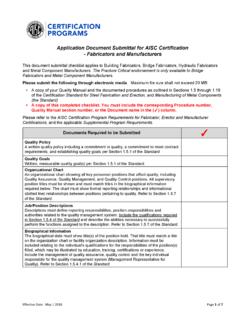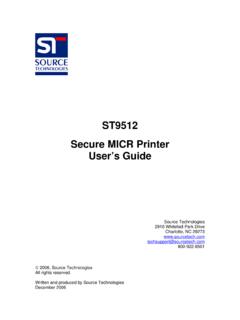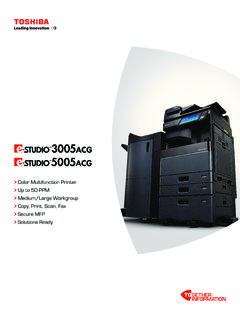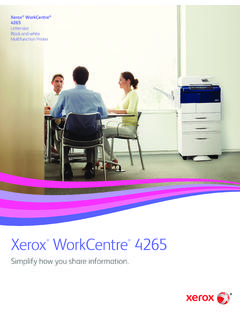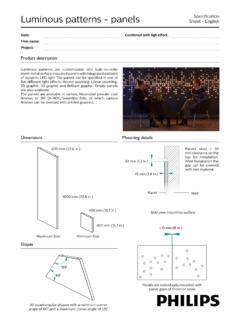Transcription of Overview and Design Examples - American Institute …
1 Bolted Field Splices for steel Bridge Flexural MembersOverview and Design Examplesi BOLTED FIELD SPLICES FOR steel BRIDGE FLEXURAL MEMBERS Overview & Design Examples Michael A. Grubb, Grubb & Associates, LLC Karl H. Frank, Hirschfeld Industries Justin M. Ocel, Federal Highway Administration ii AISC 2018 by American Institute of steel construction All rights reserved. This book or any part thereof must not be reproduced in any form without the written permission of the publisher. The AISC and NSBA logos are registered trademarks of AISC. The information presented in this publication has been prepared in accordance with recognized en-gineering principles.
2 While it is believed to be accurate, this information should not be used or relied upon for any specific application without competent professional examination and verification of its accuracy, suitability and applicability by a licensed professional engineer, designer, or architect. The publication of the material contained herein is not intended as a representation or warranty on the part of the American Institute of steel construction or of any other person named herein, that this information is suitable for any general or particular use or of freedom from infringement of any patent or patents.
3 Anyone making use of this information assumes all liability arising from such use. Caution must be exercised when relying upon other specifications and codes developed by other bodies and incorporated by reference herein since such material may be modified or amended from time to time subsequent to the printing of this edition. The American Institute of steel construction bears no responsibility for such material other than to refer to it and incorporate it by reference at the time of the initial publication of this edition. MARCH 2018 Version iii Release Notes - NSBA Splice Document Bolted Field Splices for steel Bridge Flexural Members: Overview & Design Examples Version March This version addresses the following: 1 Page 3: revised the paragraph dealing with the checking of AASHTO LRFD Eq.
4 To infer that this equation should be checked in all cases at a bolted splice at the strength limit state to account for the loss of area due to the holes in girder flanges subject to tension. 2 Page 5: removed the bullets and simplified the text regarding when the effects of St. Venant torsional shear must be considered in the Design of splices for box sections. Also added a clarification in the next paragraph regarding the consideration of flange lateral bending in the Design of splices on flanges with one web in both straight and horizontally curved girders. 3 Page 6: revised Figures and to change the variable for the web depth from Dw to D.
5 Similarly changed the variable in the computation of the moment arm, A, in the three Design Examples . 4 Page 8: revised the text to indicate that the bearing resistance of the connection is to be taken as the sum of the smaller of the shear resistance of the individual bolts and the bearing resistance of the individual bolt holes parallel to the line of the Design force. 5 Page 9: added text to the definitions of the terms Rp and U in the where list for Eq. 6 Page 12: added text to indicate that in cases where the resultant web Design force given by Eq. is calculated, the web splice is being designed to carry the Design moment (in conjunction with the flange splices) plus the factored shear resistance of the web simultaneously.
6 7 Page 13: revised Figure Also revised Figure and the accompanying text to correct an error in the computation of the horizontal force, Hw, in the web for the case of composite sections subject to negative flexure and noncomposite sections subject to positive or negative flexure see #14 below. 8 Page 16: revised the language in the 2nd paragraph of Section to reflect the correction in the computation of the horizontal force in the web, Hw see #14 below. 9 Pages 17 & 35: clarified the definition of the zero haunch assumed in Design Examples 1 and 2. 10 Page 25: revised the paragraph dealing with the checking of AASHTO LRFD Eq.
7 In Design Example 1. 11 Pages 26 & 27: added the filler plate reduction factor in the calculation of the bolt shear resistance for comparison to the bearing resistance of the bolt holes in Design Example 1. 12 Pages 34 & 45: removed the overall lengths of the flange splice plates in the schematics for Design Examples 1 and 2. 13 Pages 35 to 45: revised Design Example 2 throughout to reflect a necessary revision to the bottom-flange sizes of the girder at the splice to ensure that AASHTO LRFD Eq. iv is not violated at the splice, which resulted in a revision to the bottom-flange splice Design . 14 Pages 35 to 45: revised Design Example 2 throughout to correct the computation of the horizontal force, Hw, in the web for the case of negative flexure, which resulted in the addition of 28 bolts in the web splice.
8 An Errata has been issued to Articles and of the 8th Edition LRFD Bridge Design Specifications to correct the error in the computation of Hw for this case. Revised the schematic of the splice Design on Page 45 accordingly. 15 Pages 37 & 39: added in the thickness of the top-flange filler plate in the computation of the moment arm for the positive moment case. 16 Page 56: updated the second reference listing and included a link. 17 Pages 57 to 66: added Appendix A to the document, which describes supplemental finite-element modeling of Design Example 2, as originally reported in the FHWA report Behavior of a steel Girder Bolted Splice Connection (Ocel, 2017).
9 As a result of the two issues described in #13 and #14 above, the FHWA finite-element models of the Design Example 2 splice described in the original report were revisited and reanalyzed with the revised bottom-flange sizes and bottom-flange splice-plate sizes, the increased number of bolts in the bottom-flange splice, and the increased number of bolts in the web splice. The results of this analysis are described in the Appendix. Version May 15, 2017 This version addresses the following: 1 Page ii: added the version number. 2 Page 13: added language to the end of the paragraph below Figure to address why the statical effect of the horizontal force in the web, Hw, is ignored.
10 3 Page 19: corrected the value of Pfy used to compute the number of bolts, N, required in the bottom flange splice in Design Example 1. Version May 2, 2017 This version addresses the following: 1 Page 5: revised the language in the last paragraph dealing with the handling of flange lateral bending in the Design of bolted splices in straight I-girders and horizontally curved I-girders to provide more accurate justifications for ignoring its effect in the Design of the flange splices. 2 Page 9: added a sentence indicating that if An equals or exceeds , then should be used in the computation of the net section fracture resistance of the flange splice plates; otherwise, An should be used.



